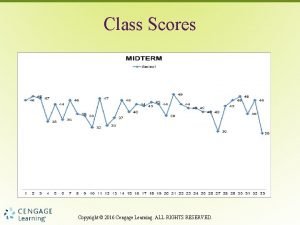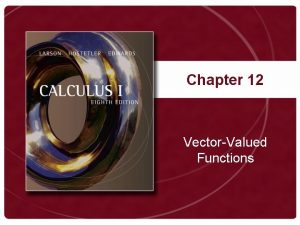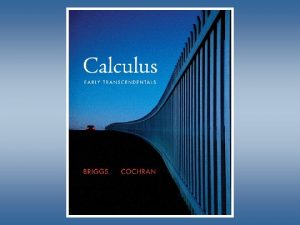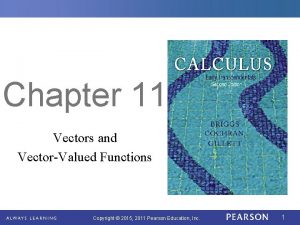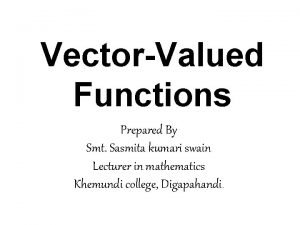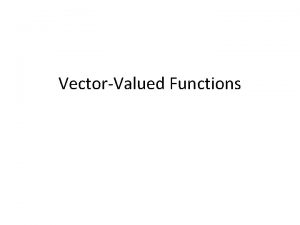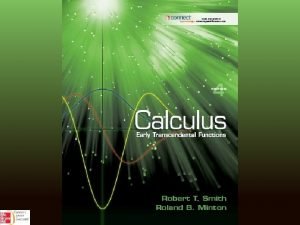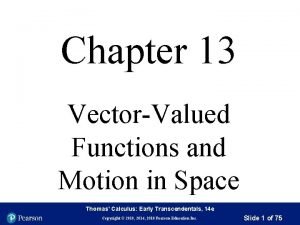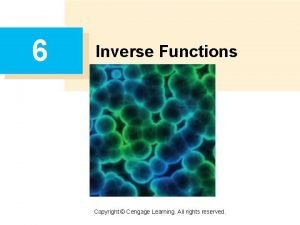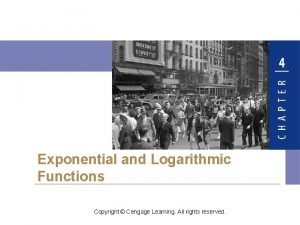12 P VectorValued Functions Copyright Cengage Learning All























- Slides: 23

12 P Vector-Valued Functions Copyright © Cengage Learning. All rights reserved.

12. 2 Differentiation and Integration of Vector-Valued Functions Copyright © Cengage Learning. All rights reserved.

Objectives n Differentiate a vector-valued function. n Integrate a vector-valued function. 3

Differentiation of Vector-Valued Functions 4

Differentiation of Vector-Valued Functions The definition of the derivative of a vector-valued function parallels the definition for real-valued functions. 5

Differentiation of Vector-Valued Functions Differentiation of vector-valued functions can be done on a component-by-component basis. To see why this is true, consider the function r(t) = f(t)i + g(t)j. Applying the definition of the derivative produces the following. 6

Differentiation of Vector-Valued Functions This important result is listed in theorem shown below. . 7

Differentiation of Vector-Valued Functions Note that the derivative of the vector-valued function r is itself a vector-valued function. You can see from Figure 12. 8 that r′(t) is a vector tangent to the curve given by r(t) and pointing in the direction of increasing t-values. Figure 12. 8 8

Example 1 – Differentiation of a Vector-Valued Function For the vector-valued function r(t) = t i + (t 2 + 2)j find r′(t). Then sketch the plane curve represented by r(t) and the graphs of r(1) and r′(1). Solution: Differentiate on a component-by-component basis to obtain r′(t) = i + 2 t j. Derivative From the position vector r(t), you can write the parametric equations x = t and y = t 2 + 2. The corresponding rectangular equation is y = x 2 + 2. When t = 1, r(1) = i + 3 j and r′(1) = i + 2 j. 9

Example 1 – Solution cont’d In Figure 12. 9, r(1) is drawn starting at the origin, and r′(1) is drawn starting at the terminal point of r(1). Note that at (1, 3), the vector r′(1) is tangent to the curve given by r(t) and is pointing in the direction of increasing t-values. Figure 12. 9 10

Differentiation of Vector-Valued Functions The parametrization of the curve represented by the vector -valued function r(t) = f(t)i + g(t)j + h(t)k is smooth on an open interval when f ′, g′, and h′ are continuous on and r′(t) ≠ 0 for any value of t in the interval . 11

Example 3 – Finding Intervals on Which a Curve Is Smooth Find the intervals on which the epicycloid C given by r(t) = (5 cos t – cos 5 t)i + (5 sin t – sin 5 t)j, 0 t 2 is smooth. Solution: The derivative of r is r′(t) = (– 5 sin t + 5 sin 5 t)i + (5 cos t – 5 cos 5 t)j. In the interval [0, 2 ], the only values of t for which r′(t) = 0 i + 0 j are t = 0, 2, , 3 2, and 2. 12

Example 3 – Solution cont’d Therefore, you can conclude that C is smooth on the intervals as shown in Figure 12. 10 13

Differentiation of Vector-Valued Functions In Figure 12. 10, note that the curve is not smooth at points at which the curve makes abrupt changes in direction. Such points are called cusps or nodes. 14

Differentiation of Vector-Valued Functions 15

Example 4 – Using Properties of the Derivative For find each derivative. a. b. 16

Example 4(a) – Solution Because and u′(t) = 2 t i – 2 j, you have 17

Example 4(b) – Solution cont’d Because u′(t) = 2 t i – 2 j and u′′(t) = 2 i, you have 18

Integration of Vector-Valued Functions 19

Integration of Vector-Valued Functions The following definition is a consequence of the definition of the derivative of a vector-valued function. 20

Integration of Vector-Valued Functions The antiderivative of a vector-valued function is a family of vector-valued functions all differing by a constant vector C. For instance, if r(t) is a three-dimensional vector-valued function, then for the indefinite integral ∫r(t) dt, you obtain three constants of integration where F′(t) = f(t), G′(t) = g(t), and H′(t) = h(t). 21

Integration of Vector-Valued Functions These three scalar constants produce one vector constant of integration ∫r(t) dt = [F(t) + C 1]i + [G(t) + C 2]j + [H(t) + C 3]k = [F(t)i + G(t)j + H(t)k] + [C 1 i + C 2 j + C 3 k] = R(t) + C where R′(t) = r(t). 22

Example 5 – Integrating a Vector-Valued Function Find the indefinite integral ∫(t i + 3 j) dt. Solution: Integrating on a component-by-component basis produces 23
 Copyright cengage learning. powered by cognero
Copyright cengage learning. powered by cognero Delmar cengage learning medical terminology
Delmar cengage learning medical terminology Medical terminology chapter 5 learning exercises answers
Medical terminology chapter 5 learning exercises answers Cengage learning heart diagram
Cengage learning heart diagram South-western cengage learning
South-western cengage learning Chapter 13 medical math assignment sheet
Chapter 13 medical math assignment sheet 2009 delmar cengage learning
2009 delmar cengage learning Cengage learning heart diagram
Cengage learning heart diagram 2009 delmar cengage learning
2009 delmar cengage learning Cengage learning australia
Cengage learning australia Graphing tpr
Graphing tpr Cengage learning
Cengage learning Cengage learning
Cengage learning Wadsworth cengage learning
Wadsworth cengage learning Cengage learning
Cengage learning Cengage learning plant cell
Cengage learning plant cell Cengage learning
Cengage learning Cengage learning
Cengage learning Brooks cole cengage learning
Brooks cole cengage learning Chapter 7 cengage
Chapter 7 cengage 2014 cengage learning accounting answers
2014 cengage learning accounting answers Cengage learning
Cengage learning Cengage learning
Cengage learning 2009 delmar cengage learning
2009 delmar cengage learning






















